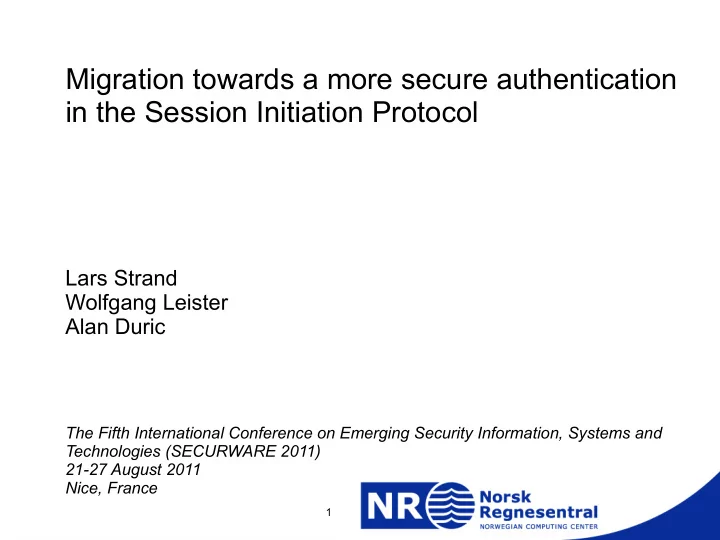

Migration towards a more secure authentication in the Session Initiation Protocol Lars Strand Wolfgang Leister Alan Duric The Fifth International Conference on Emerging Security Information, Systems and Technologies (SECURWARE 2011) 21-27 August 2011 Nice, France 1
"It's appalling how much worse VoIP is compared to the PSTN. If these problems aren't fixed, VoIP is going nowhere." --- Philip Zimmerman on VoIP security in “SIP Security”, Sisalem et. al. (2009) 2
3
VoIP? ● Voice over IP (VoIP) protocols and technology is a merge of telecom and data communication ● What is VoIP? ● Broad definition: Sending and receiving media (voice/video) over IP ● Why VoIP? ● Added functionality and flexibility – which may be hard to provide over PSTN ● Reduced cost – uses Internet as carrier ● Less administration – no separate telephone and data network ● Industry have high focus on VoIP today ● But, VoIP is known to be insecure ● Inherits problems from traditional IP networks ● Multiple attack on SIP based VoIP exists 4
SIP ● Session Initiation Protocol (SIP) is the de facto standard signaling protocol for VoIP ● Application layer (TCP, UDP, SCTP) ● Setting up, modifying and tearing down multimedia sessions ● Establishing and negotiating the context of a call ● No media transfer (voice/video) ● RTP transfer the actual multimedia ● SIP specified in RFC 3261 published by IETF 2002 ● First iteration in 1999 (RFC2543) ● Additional functionality specified in over 120 different RFCs(!) ● Even more pending drafts... ● Known to be complex and sometimes vague – difficult for software engineers to implement ● Interoperability conference - “SIPit” 5
SIP specification – huge, complex and sometimes vague 6
Excerpts from an email posted on IEFT RAI mailing list: I'm finally getting into SIP. I've got Speakeasy VoIP service, two sipphone accounts, a Cisco 7960 and a copy of x-ten on my Mac. And I still can't make it work. Voice flows in one direction only. I'm not even behind a NAT or firewall -- both machines have global addresses, with no port translations or firewalls. I've been working with Internet protocols for over 20 years. I've implemented and contributed to them. And if *I* can't figure out how to make this stuff work, how is the average grandmother expected to do so? SIP is unbelievably complex, with extraordinarily confusing terms. There must be half a dozen different "names" -- Display Name, User Name, Authorization User Name, etc -- and a dozen "proxies". Even the word "domain" is overloaded a half dozen different ways. This is ridiculous! Sorry. I just had to get this off my chest. Regards, Reference: http://www.ietf.org/mail-archive/web/rai/current/msg00082.html 7
SIP example Direct call UA to UA ● Caller must know callee's IP or hostname ● No need for intermediate SIP hosts ● Problems: – Traversing firewalls – Seldom know IP/hostname of user – Mobility – change IP/hostname 8
SIP call flow 9
Three SIP authentication scenarios 10
SIP authentication - today 1) Digest Access Authentication (DAA) (RFC3261) ● Mandatory but weak ● widespread adoption - “everyone” use this ● used to authenticate locally within a domain/realm (during REGISTER or INVITE) 2) S/MIME (RFC3261) ● Goal: Security service end to end ● Uses certificates, needs PKI = “complex and expensive” ● Not supported, not used. 3) Transport Layer Security (TLS) 1) Well-known and widely adopted technology (HTTPS) 2) SIPS have industrial momentum 3) TLS only provide hop-by-hop security, and rely on PKI. 4) Other user identity handling methods ● P-Asserted identity (RFC3325) – in a trusted environment ● Strong Identity (RFC4474) – using authentication service ● Other academic approaches. 11
WANTED: Strong and flexible authentication method in SIP! We propose a two-step migration: 1. PAKE 2. SASL 12
Problem and goal ● SIP is flexible ● Problem: Different usage scenarios have different security requirements ● Handheld devices vs. high-end SIP servers ● Goal: Modification to the SIP standard should be minimum ● Goal 2: A strong and flexible authentication methods wanted ● Solution: Add support for PAKE and SASL 13
1. PAKE ● “Password Authenticated Key Exchange” (PAKE) ● Provides mutual authentication of client and server ● Reuse the shared secret used by the DAA ● Stronger than DAA ● PAKE + HTTP currently worked on in the IETF 14
2. SASL ● Simple Authentication and Security Layer = Interface for an application to access security services ● Mature and well-proven standard (RFC4422) ● NOT a communication protocol ● Relies on the application (SIP) to pass SASL messages between client and server ● Does NOT provide any security in itself ● Relies on underlying security mechanisms ● SASL implementations (may) support different authentication methods ● Digest-MD5 ● Kerberos ● GSSAPI ● … ● All methods are transparent to the application 15
SASL stack (with SIP) 16
17
18
SIP REGISTER message DAA SASL 19
Conclusion ● We propose a two-step migration towards a more secure authentication 1.PAKE replace the weak DAA 2.SASL in the long term ● Our solution require minimal changes to the SIP protocol standard ● With SASL ● Add support to a range of different authentication methods ● Flexible – different implementations can support different authentication methods ● New authentication methods can be added later WITHOUT change to the SIP standard ● Future work ● Benchmark testing ● IETF draft ● Add an SIP extension to maintain backwards compatibility? ● SASL: Require some authentication methods to be supported as standard? Which? – Vulnerable to a REGISTRATION attack? – Compare and look into different SASL auth methods 20
Thank you! 21
Recommend
More recommend